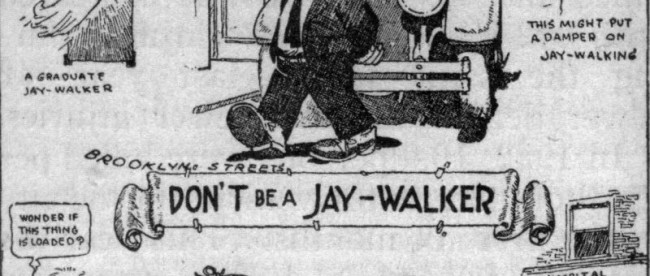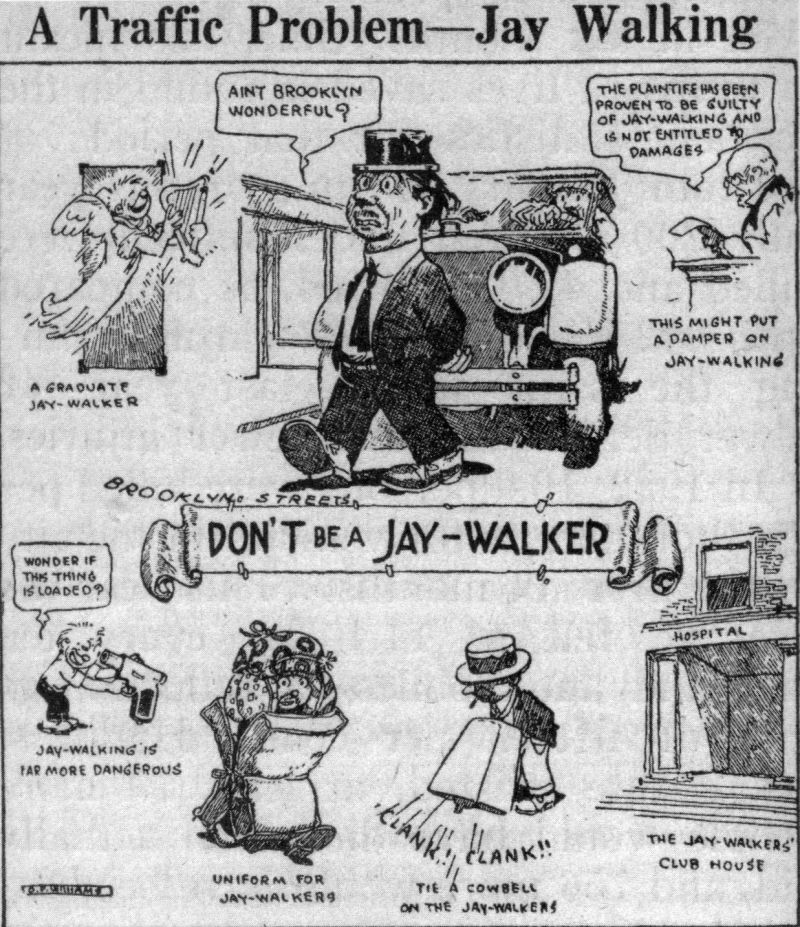The Rise and Fall of the Flivverboobs

The general rule for American motorists is that pedestrians have the right of way. That is, in most cases, if someone wants to cross the street, drivers are supposed to stop and let the person on foot continue. On one level, that’s a sensible rule: if a moving car and a pedestrian both aim to occupy the same space, the car is almost certainly going to win that battle.
But such accidents are best avoided when both motorist and pedestrian alike consider the other. We have things like crosswalks and traffic signals to aid in that effort to instill mutual respect, but that’s not always enough, so we also have laws. Today, a handful of jurisdictions have laws against what’s known as “jaywalking” — when a pedestrian enters a roadway when he or she shouldn’t.
Jaywalking, though, seems antithetical to our initial premise that pedestrians have the right of way — if cars are to yield to those on foot, regardless of the situation, why do we single out some situations where pedestrians are to blame? To see why one has to look to the history of the term “jaywalker.”
A century ago, the odds of being killed or maimed by a motorist were pretty low, and any criminal penalties for meandering into traffic were similarly unlikely. So, as Gizmodo explains, drivers decided to turn to name calling, making up the term “jaywalker” as part of “a massive shaming campaign,” the extent of which is by today’s standards pretty amazing. As UVA Today (a publication of the University of Virginia) notes, the effort could even earn a child a merit badge: “To spread this new term of abuse, several cities used Boy Scouts to hand out cards to pedestrians telling them that they had just become ‘jaywalkers.'” Editorial cartoonists also got into the game:

The campaign worked, as evidenced by the fact that the term “jaywalking” is still in our vocabularies a century later — and by the fact that plans to protect pedestrians are still the forefront of public governance conversations. Pedestrians were, seemingly suddenly, expected to give way to the machines.
So, why didn’t pedestrians strike back with a parallel term of derision? They did. And it failed. The July 9, 1922 edition of the New York Times devoted a few words to the cause:
Reckless and careless drivers of automobiles will be known as “flivverboobs,” according to the decision reached by the judges deciding the American Automobile Association’s contest to pick a name describing the reckless driver in the same manner that “jay-walker” describes the careless pedestrian. The name was suggested by F.B. Simpson of Cedar Rapids, Iowa, who will receive the $25 prize offered by the AAA.
(That $25 prize was rather meaningful; it’s equivalent to about $360 today, accounting for inflation.)
The word “flivverboob” followed a formula similar to “jaywalker” — “boob,” like “jay,” was slang for an unsophisticated person — one unfamiliar with the technological advancements of modern city life. The word “flivver” was slang for “cheap car” — and while its origins are unknown, it was used as early as 1910 to refer to the Model T, so the people of 1922 probably were somewhat familiar with it.
And opinion-makers of the day tried to adopt it. In September of that year, just a few weeks after F.B. Simpson earned his or her prize, the Chicago Tribune ran a feature on the plight of the flivverboobs, calling these absent-minded drivers a “horrible example” of how to act, and noting that they killed 12,000 people and injured another 1.5 million the year prior. The term “flivver” became increasingly more common in books published over the next year, too.
But ultimately, the campaign to shame drivers fell flat. The importance of the car in everyday life increased rapidly, as did the tolerance for drivers (and an intolerance toward pedestrians who got in the way). Within a year, the campaign to turn bad drivers into flivverboobs evaporated without even so much as a press mention. But jaywalking? That insult would remain popular for decades to come.
Bonus fact: As of 2004, New York City’s crosswalks, collectively, had approximately 3,250 buttons which pedestrians could push to change a “don’t walk” symbol to a “walk” one. Well, kind of. As the New York Times reported that year, most of the buttons did nothing. As the city moved to computer-controlled traffic lights, they also disconnected the “walk” buttons from the system — but left the button themselves for those who wanted the false sense of control. (“More than 2,500 of the 3,250 walk buttons that still exist function essentially as mechanical placebos,” the Times noted, as “any benefit from them is only imagined.”) There’s one exception, though. Some newer buttons say “to cross, push button,” and they’re not placebos. They don’t make the light change more quickly, though; per the Times, they give an audible signal that informs visually impaired pedestrians that the light has changed, and it’s safe to cross.
From the Archives: Mayor, Mock Us: The mayor who hired 420 mimes to mock jaywalkers — which, for him, wasn’t that weird, because he did a lot of weird things.
Related: Milles Bornes, a card game for the wannabe flivverboob.
